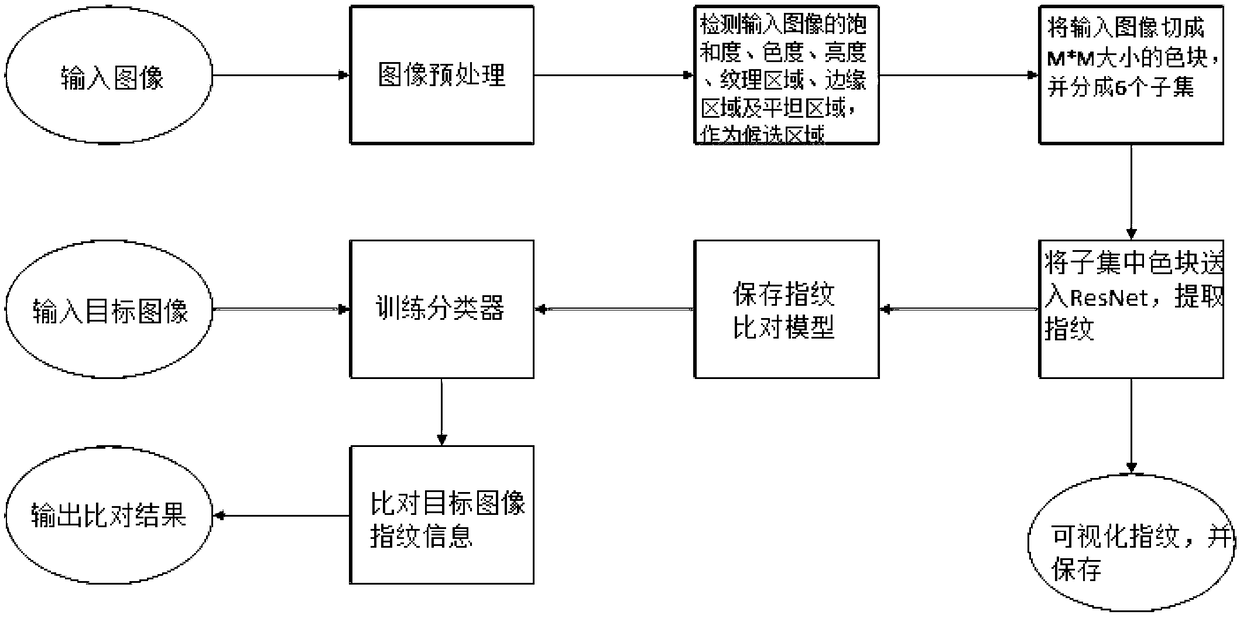A non-uniform fingerprint extraction and comparison method for camera light response based on combined feature representation
A technology of non-uniformity and combined features, applied in the field of computer vision, can solve the problems of unfavorable video fingerprint real-time extraction, high algorithm complexity, high resource occupation rate, etc., to improve detection efficiency and detection accuracy, algorithm complexity is small, The effect of high space occupancy
- Summary
- Abstract
- Description
- Claims
- Application Information
AI Technical Summary
Problems solved by technology
Method used
Image
Examples
Embodiment 1
[0091] A camera light response non-uniformity fingerprint extraction and comparison method based on combined feature representation, such as figure 1 As shown, the specific steps are as follows:
[0092] (1) Perform image preprocessing on the input image;
[0093] (2) Detect the saturation, chroma, brightness, texture area, edge area and flat area of the input image, and use the detected corresponding feature area as a candidate area for camera photoresponse non-uniformity fingerprint extraction;
[0094] (3) According to the candidate area, the input image is cut into M*M size color patches (patch), the value of M is not greater than the value of the original image pixel (or resolution), and these color patches are evenly extracted , divided into 6 subsets; here the 6 subsets are six subsets of saturation, chroma, brightness, texture area, edge area and flat area;
[0095] M=32 or M=64 or M=128.
[0096] (4) Send the color blocks in each subset to the residual network (R...
Embodiment 2
[0099] According to the method for extracting and comparing fingerprints of non-uniformity of camera photoresponse based on combined feature representation described in Embodiment 1, the difference is that:
[0100] In step (1), image preprocessing is carried out to the input image, including steps as follows:
[0101] A. Normalize the input image to form a unified standard format image; for example, uniformly zoom any input image into a JPG format image with a size of 4000*3000, where the zoom size needs to be greater than the color block size M;
[0102] B. Perform color space conversion on the image processed in step A, that is, convert from the original RGB color space to the HSI color space.
[0103] In step (2), detect input image saturation, chroma, brightness, texture area, edge area and flat area, as candidate area; Include steps as follows:
[0104] C. Set the input image P. For the input image P, first calculate the mean (mean) and standard deviation (standard devi...
Embodiment 3
[0151] A camera light response non-uniformity fingerprint extraction and comparison method based on combined feature representation, the specific steps are as follows:
[0152] (1) Carry out image preprocessing to input image; Include steps as follows:
[0153] A. Uniformly scale any input image into a JPG format image with a size of 3456*2592;
[0154] B. Perform color space conversion on the image processed in step A, that is, convert from the original RGB color space to the HSI color space.
[0155] (2) Detect the saturation, chroma, brightness, texture area, edge area and flat area of the input image, and use the detected corresponding feature area as the candidate area for the camera photoresponse non-uniformity fingerprint extraction; the steps are as follows:
[0156] C. Set the input image P. For the input image P, first calculate the mean (mean) and standard deviation (standard deviation) of the pixel values, and the value range of the pixel values is [0,255]:
...
PUM
 Login to View More
Login to View More Abstract
Description
Claims
Application Information
 Login to View More
Login to View More - R&D
- Intellectual Property
- Life Sciences
- Materials
- Tech Scout
- Unparalleled Data Quality
- Higher Quality Content
- 60% Fewer Hallucinations
Browse by: Latest US Patents, China's latest patents, Technical Efficacy Thesaurus, Application Domain, Technology Topic, Popular Technical Reports.
© 2025 PatSnap. All rights reserved.Legal|Privacy policy|Modern Slavery Act Transparency Statement|Sitemap|About US| Contact US: help@patsnap.com



